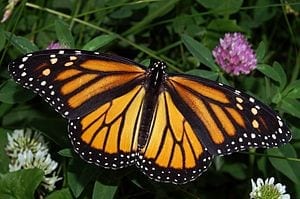
Fewer than three million monarch butterflies have shown up so far this year
ON the first of November, when Mexicans celebrate a holiday called the Day of the Dead, some also celebrate the millions of monarch butterflies that, without fail, fly to the mountainous fir forests of central Mexico on that day. They are believed to be souls of the dead, returned.
This year, for or the first time in memory, the monarch butterflies didn’t come, at least not on the Day of the Dead. They began to straggle in a week later than usual, in record-low numbers. Last year’s low of 60 million now seems great compared with the fewer than three million that have shown up so far this year. Some experts fear that the spectacular migration could be near collapse.
“It does not look good,” said Lincoln P. Brower, a monarch expert at Sweet Briar College.
It is only the latest bad news about the dramatic decline of insect populations.
Another insect in serious trouble is the wild bee, which has thousands of species. Nicotine-based pesticides called neonicotinoids are implicated in their decline, but even if they were no longer used, experts say, bees, monarchs and many other species of insect would still be in serious trouble.
That’s because of another major factor that has not been widely recognized: the precipitous loss of native vegetation across the United States.
“There’s no question that the loss of habitat is huge,” said Douglas Tallamy, a professor of entomology at the University of Delaware, who has long warned of the perils of disappearing insects. “We notice the monarch and bees because they are iconic insects,” he said. “But what do you think is happening to everything else?”
A big part of it is the way the United States farms. As the price of corn has soared in recent years, driven by federal subsidies for biofuels, farmers have expanded their fields. That has meant plowing every scrap of earth that can grow a corn plant, including millions of acres of land once reserved in a federal program for conservation purposes.
Another major cause is farming with Roundup, a herbicide that kills virtually all plants except crops that are genetically modified to survive it.
As a result, millions of acres of native plants, especially milkweed, an important source of nectar for many species, and vital for monarch butterfly larvae, have been wiped out. One study showed that Iowa has lost almost 60 percent of its milkweed, and another found 90 percent was gone. “The agricultural landscape has been sterilized,” said Dr. Brower.
The loss of bugs is no small matter. Insects help stitch together the web of life with essential services, breaking plants down into organic matter, for example, and dispersing seeds. They are a prime source of food for birds. Critically, some 80 percent of our food crops are pollinated by insects, primarily the 4,000 or so species of the flying dust mops called bees. “All of them are in trouble,” said Marla Spivak, a professor of apiculture at the University of Minnesota.
Farm fields are not the only problem.
The Latest Google Headlines on:
Monarch butterfly
[google_news title=”” keyword=”Monarch butterfly” num_posts=”10″ blurb_length=”0″ show_thumb=”left”]
The Latest Bing News on:
Monarch butterfly
- New Port Richey celebrating its role in protecting Monarch butterflieson May 1, 2024 at 2:14 pm
New Port Richey is one of a handful of places in Florida designated as a Monarch City because of its dedication to the cause.
- Where to spot the world’s most beautiful butterflieson April 30, 2024 at 1:43 am
As you travel the world and explore, you can spot different butterflies, admire their beauty and learn more about them.
- Nature lovers learn to give butterflies safe sanctuaryon April 28, 2024 at 11:00 pm
With the natural habitat of monarch butterflies disappearing a local group of environmentalists hosted a learning event Saturday about the species.
- Misinformation could cause Floridians to harm, not help, monarch butterflies, a scientist sayson April 26, 2024 at 10:17 am
An open letter from a researcher reveals that Floridians could be inadvertently contributing to the spread of a life-threatening parasite among monarch butterflies.
- Misinformation is causing Floridians to harm, not help, monarch butterflieson April 24, 2024 at 12:20 pm
An open letter from a researcher reveals that Floridians are inadvertently contributing to the spread of a life-threatening parasite among monarch butterflies.
- Monarch population rapidly declining due to lack of host planton April 23, 2024 at 4:45 pm
According to Shiloh Museum master gardener Marty Powers, this is because of the decreasing number of milkweed plants. The milkweed plant is the only plant monarch butterflies can lay their eggs on and ...
- Master Gardener: Planting milkweed helps support vulnerable migrating monarch butterflieson April 22, 2024 at 8:00 pm
The monarch butterflies we see here in northeastern Oklahoma are Eastern monarchs. These monarchs visit us twice a year.
- Mexico’s avocado industry harms monarch butterflies, will U.S. officials act? (commentary)on April 22, 2024 at 8:30 am
Monarch butterflies are returning to gardens across the United States, but a few months ago, I stood in a mountain forest in Mexico where the monarchs spend the winter. They clustered on trees by the ...
- Love monarchs? What to grow this year to see more butterflies in your yardon April 21, 2024 at 8:24 am
If you love monarch butterflies, you’re in luck: Spring gardening season unfolds just as these iconic insects are migrating back into the U.S., making right now a great time to think about adding ...
- ODOT starts mowing early along I-35, experts talk possible impact on monarch butterflieson April 19, 2024 at 3:25 pm
Concerns surrounding the safety of monarch butterflies. How a change in ODOT's mowing protocol could impact the insects as they migrate through Oklahoma.
The Latest Google Headlines on:
Monarch Butterflies
[google_news title=”” keyword=”Monarch Butterflies” num_posts=”10″ blurb_length=”0″ show_thumb=”left”]
The Latest Bing News on:
Monarch Butterflies
- New Port Richey celebrating its role in protecting Monarch butterflieson May 1, 2024 at 2:14 pm
New Port Richey is one of a handful of places in Florida designated as a Monarch City because of its dedication to the cause.
- Where to spot the world’s most beautiful butterflieson April 30, 2024 at 1:43 am
As you travel the world and explore, you can spot different butterflies, admire their beauty and learn more about them.
- Misinformation could cause Floridians to harm, not help, monarch butterflies, a scientist sayson April 26, 2024 at 10:17 am
An open letter from a researcher reveals that Floridians could be inadvertently contributing to the spread of a life-threatening parasite among monarch butterflies.
- Misinformation is causing Floridians to harm, not help, monarch butterflieson April 24, 2024 at 12:20 pm
An open letter from a researcher reveals that Floridians are inadvertently contributing to the spread of a life-threatening parasite among monarch butterflies.
- Master Gardener: Planting milkweed helps support vulnerable migrating monarch butterflieson April 22, 2024 at 8:00 pm
The monarch butterflies we see here in northeastern Oklahoma are Eastern monarchs. These monarchs visit us twice a year.
- Mexico’s avocado industry harms monarch butterflies, will U.S. officials act? (commentary)on April 22, 2024 at 8:30 am
Monarch butterflies are returning to gardens across the United States, but a few months ago, I stood in a mountain forest in Mexico where the monarchs spend the winter. They clustered on trees by the ...
- Love monarchs? What to grow this year to see more butterflies in your yardon April 21, 2024 at 8:24 am
If you love monarch butterflies, you’re in luck: Spring gardening season unfolds just as these iconic insects are migrating back into the U.S., making right now a great time to think about adding ...
- ODOT starts mowing early along I-35, experts talk possible impact on monarch butterflieson April 18, 2024 at 6:04 pm
Concerns surrounding the safety of monarch butterflies. How a change in ODOT's mowing protocol could impact the insects as they migrate through Oklahoma.
- Monarch butterflies are missing. What's to blame for their shrinking population.on April 17, 2024 at 3:18 pm
Monarch butterflies are well known, but have you noticed they're appearing less? The shrinking population is alarming.
- 🦋 How to See the Mexico Butterflies Migration in 2024on April 17, 2024 at 8:07 am
Ready to learn more about the migration of butterflies to Mexico? From which Mexico butterfly sanctuary is the best, to the best Mexico butterfly tours and what to pack for your visit — it’s all ...









